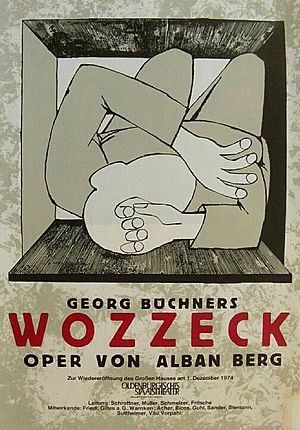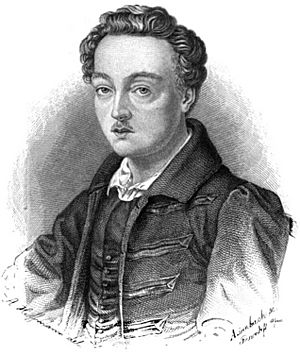Wozzeck facts for kids
Quick facts for kids Wozzeck |
|
|---|---|
| by Alban Berg | |

1974 poster of Oldenburgisches Staatstheater
|
|
| Librettist | Berg |
| Language | German |
| Premiere | 14 December 1925: Berlin State Opera |
Wozzeck is a famous opera by the Austrian composer Alban Berg. He wrote it between 1914 and 1922, and it was first performed in 1925. The opera is based on a play called Woyzeck by the German writer Georg Büchner. Büchner never finished his play.
Berg saw Büchner's play in 1914 and immediately knew he wanted to turn it into an opera. He chose 15 scenes from Büchner's unfinished play and arranged them into three acts, each with five scenes. Berg wrote the words for the opera himself, keeping the play's quick scenes and strong, realistic style.
The story of Wozzeck shows the daily lives of soldiers and people in a small German town. It explores themes like how tough military life can be, how some people treat others without kindness, and how people can be unfairly used by society. The main character, Wozzeck, feels very sad and alone. At one point, he whispers, "Still, all is still, as if the world died." This shows his deep sadness and how he feels about the world around him.
Contents
How Wozzeck Was Created

Alban Berg started working on Wozzeck in 1914. However, World War I began, which slowed down his progress. He could only work on the opera when he was on leave from his military duties in 1917 and 1918. His experiences during the war greatly influenced the opera.
In a letter to his wife in 1918, Berg wrote that he felt a bit like Wozzeck. He felt trapped and unhappy, just like the character in the opera. His notes from the war years show how much he wanted to finish Wozzeck.
During the war, Berg's notes for Wozzeck often included military words and ideas. For example, he put sounds of bugle calls (military signals) into the music. These sounds were changed a bit, but people in Austria at the time would likely have recognized them. The scene where soldiers snore in the barracks was inspired by Berg's own experience. He described the sounds of their breathing as "primeval music" coming from deep within the soul.
In 1916, Berg became a corporal in the army. He wrote to his wife that he hadn't worked on Wozzeck for months because everything felt "suffocated." He finished the first act by 1919, the second act in 1921, and the final act in the next two months. He finished all the music for the orchestra by April 1922. For an important part of the opera, he even used one of his old student pieces.
First Performances of Wozzeck
Erich Kleiber, a conductor, decided on his own to put Wozzeck on stage. He led the very first performance at the Berlin State Opera on December 14, 1925. The opera caused a stir, with some people liking it and others not. But it quickly became popular in Germany and Austria.
However, after 1933, the Nazis called it "degenerate art" and banned it. Before that, Wozzeck had become a regular part of opera shows in Europe. Berg was able to live comfortably from the money he earned from the opera. He spent a lot of time traveling to watch performances and give talks about his work.
The opera had its first American performance in Philadelphia on March 19, 1931. Leopold Stokowski conducted it. The first full performance in Britain was on January 14, 1934, in London. The first staged performance in Britain was at the Royal Opera House in London on January 22, 1952.
A typical performance of Wozzeck lasts a little over an hour and a half.
Music Style and Structure
Wozzeck is often seen as one of the first important operas of the 20th century's avant-garde (new and experimental) style. It's also a famous example of atonality, which means the music does not follow a traditional key. It also uses Sprechgesang, a special way of singing that is halfway between speaking and singing.
Berg followed his teacher, Arnold Schoenberg, by using atonal music. This helped to show the strong feelings and even the thoughts of the characters on stage. The atonal music made the feelings of madness and feeling alone even stronger.
The music in Wozzeck is atonal. This means it doesn't use the major/minor key system that was common in music for hundreds of years. Instead, it uses other ways to control the pitches and harmonies. For example, the musical interval called a tritone (like the notes B and F) represents Wozzeck and Marie, showing their constant struggles. The notes B♭ and D♭ (a minor third) show the connection between Marie and her child. The opera often returns to certain pitches to highlight important moments in the story. This creates a sense of order and structure, even without a traditional key.
Instruments Used in Wozzeck
Wozzeck uses a fairly large orchestra. It also has three groups of musicians who play on the stage, separate from the main orchestra. These include a marching band, a chamber orchestra, and a tavern band. An upright piano is also played in one scene.
Main Orchestra (Pit Orchestra)
|
|
Special Onstage Music Groups
Marching band (Act I, scene iii):
|
|
|
Berg noted that musicians from the main orchestra could play in the marching band.
Tavern band (Act II, scene iv):
|
|
Also, for the tavern scene in Act III, scene iii, Berg asks for an out-of-tune upright piano.
Chamber orchestra (Act II, scene iii):
|
|
The instruments for this group are the same as those used in Schoenberg's Chamber Symphony No. 1.
Other Versions of Wozzeck
Besides Berg's opera, there are other musical works based on Büchner's play Woyzeck. For example, German composer Manfred Gurlitt also created an opera called Wozzeck. It was first performed four months after Berg's opera, and Gurlitt created it without knowing about Berg's work. However, Berg's Wozzeck became much more famous.
There are also shorter versions of Berg's opera. One was made for 22 singers and 21 instruments by Canadian composer John Rea. Another was made for a smaller orchestra (about 60 players) by composer Erwin Stein in cooperation with Berg himself. This version was for smaller theaters.
Recordings of Wozzeck
Many recordings of Wozzeck have been made over the years. Here are some of them:
- Roman Trekel (Wozzeck), Anne Schwanewilms (Marie), conducted by Hans Graf. Label: Naxos, 2017.
- Franz Hawlata (Wozzeck), Angela Denoke (Marie), conducted by Sebastian Weigle. Label: Opus Arte, 2006.
- Franz Grundheber (Wozzeck), Waltraud Meier (Marie), conducted by Daniel Barenboim. Label: Teldec, 1994.
- Franz Grundheber (Wozzeck), Hildegard Behrens (Marie), conducted by Claudio Abbado. Label: Deutsche Grammophon, 1987.
- Eberhard Waechter (Wozzeck), Anja Silja (Marie), conducted by Christoph von Dohnányi. Label: Decca, 1979.
- Toni Blankenheim (Wozzeck), Sena Jurinac (Marie), conducted by Bruno Maderna. Label: Arthaus Musik, 1970.
- Walter Berry (Wozzeck), Isabel Strauss (Marie), conducted by Pierre Boulez. Label: Columbia, 1966.
- Dietrich Fischer-Dieskau (Wozzeck), Evelyn Lear (Marie), conducted by Karl Böhm. Label: Deutsche Grammophon, 1965.
- Tito Gobbi (Wozzeck), Dorothy Dow (Marie), conducted by Nino Sanzogno. Label: /RAI/Myto, 1955 (sung in Italian).
- Mack Harrell (Wozzeck), Eileen Farrell (Marie), conducted by Dimitri Mitropoulos. Label: Columbia (FCX 157–FCX 158), 1951.
Film Version
The 1970 production of Wozzeck by the Hamburg State Opera was made into a TV film in 1972. It was directed by Joachim Hess and shown on Norddeutscher Rundfunk. The filming took place in and around an empty castle.
See also
In Spanish: Wozzeck (Berg) para niños

